
Spring is here and soon you’ll be caught up in a frenzy of seed sowing, growing, and nurturing your garden as it comes back to life.
As gardeners, the cusp between late winter and early spring is full of anticipation – garden beds that lay bare throughout the colder months are suddenly full of potential as you begin thinking about what to grow.
Right now, it’s time to replenish beds, pots, and planters with soil conditioners and a little extra mulch.
Refresh your soil
Ensure your soil is ready for new plants by turning it over with a pitchfork, raking it out, and clearing any weeds that may have grown over the winter.
Follow this by incorporating well-rotted manure or compost into the soil and adding a sprinkle of organic fertiliser, such as chicken manure pellets. If you have a compost bin, use your leftover food scraps or store-bought compost to add nutrients to the soil. Remember to add the compost or manure a few weeks before you begin planting, so it has time to marry with your soil and won’t burn the roots of your new plants.
Get mulching
Mulching is a must in early spring as it delivers multiple benefits to your garden beds and pots.
Once your soil is well-nourished and moist from the compost or manure, add a thick, generous layer of mulch to conserve the damp conditions and fend off weeds.
To prevent rot, don’t forget to avoid the space immediately around the stems and trunks of each plant.
Planting in pots
If you’re adding new plants to pots, start by covering any holes with small pieces of flyscreen which will allow adequate drainage without letting too much soil loose each time you water.
Use spare tiles beneath your pots’ edges to keep them elevated for improved drainage. Fill the inside with a premium potting mix, packing down gently as you go.
If you’re only topping up your pots, start by aerating the existing soil and scooping some out to make way for healthier earth. Finish off your pots with premium potting mix, compost, or worm castings for beneficial bacteria, microbes, and fungi.
Now is the best time to re-pot any plants that may have outgrown their previous homes. Remove your plant along with any leftover soil, trim off any unruly roots, re-plant in the new pot, top with new healthy soil to encourage further growth, and feed with a water and seaweed solution.
Why choose planter boxes
Like pots, planter boxes are great options for gardens with limited space or are great additions to larger yards to protect new plants from existing root systems.
Get your new planter box started by covering your drainage holes with flyscreen and packing them with a premium potting or planter box mix and some compost sprinkled on top, followed by a light mulch to prevent moisture loss.
When topping up your existing planter boxes, ensure the dirt levels don’t exceed the space two centimetres from the top. Add and aerate new compost by turning it over with your spade.
To re-awaken your plant’s roots and encourage better water movement, aerate your planter boxes regularly.
The correct way to plant vegetables
Before you begin preparing your garden beds, consider their position in your yard.
For veggies, seek out a spot that gets full sun or at least six hours of direct sunlight per day.
Consider planting your seeds in a raised bed – between three and six centimetres high is recommended.
If you’ve dug into your garden and found less than ideal soil, don’t panic. Poor earth can be easily improved by adding organic matter to correct the pH levels and allow for improved nutrient intake.
If you’re simply topping up your garden beds for spring, check the pH of your soil, add organic matter, and complete the process with two centimetres of sugar cane mulch.
Homemade vs. commercial soil
When beginning any new gardening project, it’s always a safer option to purchase soil and compost. Nurseries and landscape yards sell bagged products in bulk and will often include the option of delivery directly to your door.
Generating a compost ecosystem from scratch that will adequately nurture new plants, may take years. To give your plants the best opportunity for growth, leave two centimetres at the top of your pots and beds for commercial soil or mulch, or homemade compost.
Getting your garden ready for spring needn’t be a chore. Before you begin planting, get your soil in the best possible state to get growing again after winter.
Start now to get a head start on spring and see your garden in the best shape it’s been all year.

